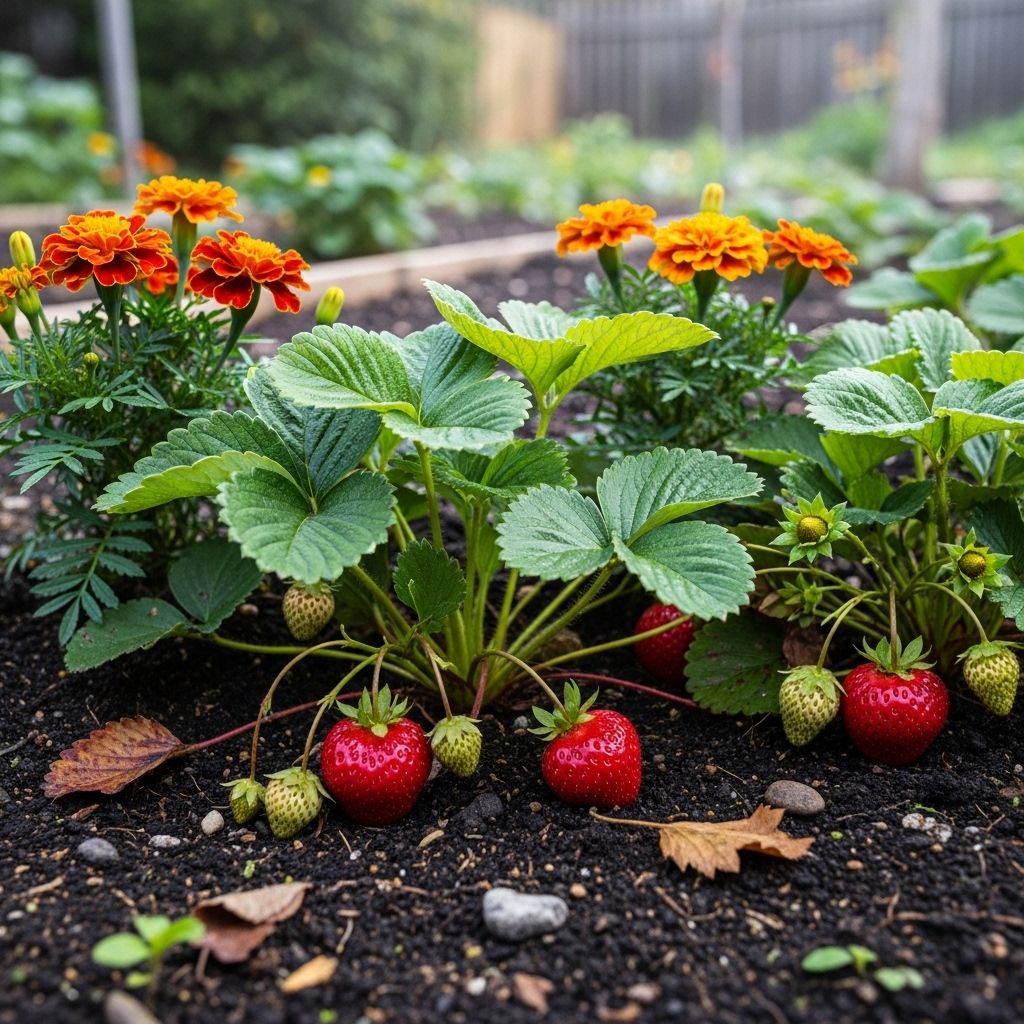Can Marigolds Be Planted With Strawberries: A Gardener’s Guide
A planting partnership that protects crops, enriches soil, and attracts pollinators.

Can Marigolds Be Planted With Strawberries in Your Garden?
Pairing strawberries and marigolds is not just a matter of aesthetics; it’s a time-tested strategy in companion planting that offers real benefits for garden health, productivity, and visual appeal. Both are sun-loving, heat-tolerant, and drought-resistant, making them compatible neighbors in garden beds or containers. This guide explores why marigolds and strawberries make such a powerful combination, how to plant them effectively, and what science and gardeners’ experience reveal about their partnership.
Why Plant Strawberries With Marigolds?
- Pest Deterrence: Marigolds have a strong scent and produce compounds in their roots and flowers that repel nematodes, aphids, whiteflies, rabbits, and even some fungal pathogens.
- Soil Health: Marigolds improve soil quality by suppressing weeds, cycling organic matter, and releasing natural pesticide compounds into the soil to control root pests.
- Attracting Beneficial Insects: The bright blooms of marigolds draw in pollinators and beneficial insects like ladybugs and hoverflies, which help control strawberry pests and enhance pollination for bigger and more abundant berries.
- Aesthetic Value: Planting marigolds adds vibrant color and visual appeal to strawberry beds, creating a beautiful and productive display.
- Growth Compatibility: Both plants have similar sun, soil, and watering needs, reducing resource competition and maximizing garden efficiency.
Together, strawberries and marigolds support each other, improving plant health, protecting against yield loss, and making your garden more visually engaging and resilient.
The Short Answer
Yes, marigolds can be planted with strawberries. When grown together in full sun and well-draining soil, marigolds help deter pests, enrich the soil, and encourage beneficial insects while strawberries thrive and produce abundant fruit. Gardeners in different climates and regions have found this pair especially successful in both beds and containers.
With thoughtful placement and care, their relationship is symbiotic and rarely competitive.
Key Benefits of Companion Planting
- Repelling Harmful Insects: Marigolds’ pungent aroma and secretions deter common garden pests, protecting both leaves and roots.
- Root Knot Nematode Suppression: Nematodes are microscopic worms that damage strawberry roots, but compounds from marigold roots drastically reduce their populations.
- Disease Management: Fungal diseases such as Fusarium are less likely to take hold when strawberries are planted with marigolds.
- Attracting Pollinators: More bees and hoverflies visit the mixed beds, improving strawberry pollination and increasing yields.
- Drought Resistance: Both are resilient plants in hot, dry weather — marigolds are especially useful in drought-prone gardens where water conservation is crucial.
- Visual Harmony: The compact growth habit of French marigolds fits neatly between or around strawberry plants without shading or overcrowding them.
How Marigolds Benefit Strawberries: Detailed Breakdown
| Benefit | Mechanism | Garden Impact |
|---|---|---|
| Pest Control | Releases scents and root compounds that repel nematodes, aphids, whiteflies, rabbits | Reduces damage to strawberries; less pest pressure |
| Soil Health | Adds organic matter with spent blooms and leaves; suppresses weeds | Soil stays richer, more aerated; less competition for nutrients |
| Pollinator Attraction | Bright flowers attract bees, hoverflies, ladybugs | Improved pollination; greater berry yields |
| Companion Compatibility | Similar sun, water, and soil needs | Simplifies care and planning |
| Aesthetic Value | Bold flower colors enhance garden beds | Attracts human attention; pleasant, diverse landscapes |
Which Marigold Varieties Work Best?
French Marigolds (Tagetes spp.) are among the best options for companion planting with strawberries. Their compact growth, persistent blooms, and powerful pest-fighting abilities set them apart. While all marigolds offer benefits, French and African marigolds are particularly well-researched for pest control and soil quality improvement.
Why French Marigolds?
- Stay compact, so they don’t swamp or shade strawberries
- Bloom continuously, providing season-long protection and color
- Known to suppress soil-borne nematodes and repel above-ground insect threats
- Easy to interplant—one every 3–4 feet or at the corners of raised beds
How to Plant Strawberries and Marigolds Together
To maximize the benefits and prevent any issues, follow these guidelines when establishing a shared bed or container:
- Sunlight: Place both in locations that get at least 6–8 hours of sun daily.
- Spacing: Plant marigolds at the corners of strawberry beds or intermix every 3–4 feet along rows. Ensure neither plant is crowded to reduce competition and allow good air circulation.
- Soil: Use well-draining, slightly acidic to neutral soil rich in organic material. Mulch well to maintain moisture.
- Watering: Both prefer regular, moderate watering — avoid waterlogged roots by ensuring good drainage.
- Rotation and Replanting: Replace or rotate marigolds annually for continued pest and soil benefits.
Step-by-Step Planting Guide
- Choose disease-free strawberry runners or young plants and healthy marigold seedlings.
- Arrange strawberries in rows or a grid, depending on bed or container size.
- Insert marigold plants at the corners and between every 3–4 strawberry plants.
- Add mulch to retain moisture and reduce weed competition.
- Water thoroughly after planting; keep the soil consistently moist but not soggy.
- Monitor for pests and remove faded marigold blooms to encourage continuous flowering.
Companion Planting: Best Friends and Worst Enemies for Strawberries
Other Great Strawberry Companions
- Borage: Increases pollinator activity and attracts natural pest predators.
- Chamomile: Lures beneficial insects and helps with pollination.
- Yarrow: Draws ladybugs and lacewings while its aroma deters some pests.
- Lettuce and Spinach: Share similar soil and light requirements, growing well beneath the spreading strawberry leaves.
- Garlic and Onions: Offer additional pest-repelling properties.
Plants to Avoid Near Strawberries
- Nightshades: (Tomatoes, potatoes, peppers, eggplant) — Can transmit fungal diseases to strawberries.
- Cucurbits: (Cucumbers, melons, squash) — Compete aggressively for nutrients and water; prone to soil diseases.
- Brassicas: (Broccoli, cabbage, kale) — Compete for resources and may impact strawberry growth negatively.
Potential Challenges and Precautions
- Competition for Nutrients: While marigolds are unlikely to outcompete strawberries when spaced well, overcrowding or poor soil fertility can cause issues—supplement with organic matter if necessary.
- Overwatering: Both are tolerant of drought once established, but too much water or poor drainage can invite disease.
- Annual Replanting: Marigolds only live one season in most regions, so replant each year for continued benefits.
- Pest Pressure Not Eliminated: While marigolds deter many common pests, they won’t stop every problem—check plants regularly and use integrated pest management.
Tips for Success
- Deadhead marigolds to encourage more blooms throughout the season.
- Apply mulch or straw around both plants to minimize weeds and conserve moisture.
- Avoid synthetic fertilizers that may inadvertently harm beneficial soil organisms.
- Grow marigolds from seed to have a continuous, cost-effective supply.
Frequently Asked Questions (FAQs)
Q: Do strawberries and marigolds compete for nutrients?
A: When spaced properly and grown in healthy soil, competition is minimal. Marigolds’ shallow roots and compact size help them coexist without overshadowing strawberries.
Q: How close should marigolds be planted to strawberries?
A: For maximum benefit, position marigolds at the corners of beds and every 3–4 feet along strawberry rows. This ensures pest deterrence without crowding the berries.
Q: Will marigolds attract pollinators to my strawberries?
A: Absolutely! Their vivid blooms attract bees, ladybugs, and hoverflies, all of which support strawberry pollination and yield.
Q: Can marigolds help prevent strawberry diseases?
A: Yes. Their root compounds suppress soil-borne pathogens, particularly nematodes and certain fungi, which can reduce disease pressure in strawberry beds.
Q: Are all marigold types suitable for companion planting with strawberries?
A: French and African marigolds are excellent choices due to their compact growth and powerful pest-repelling properties. Avoid tall varieties that may shade the strawberries or compete for light.
Conclusion: A Winning Combination for Home Gardeners
Companion planting strawberries and marigolds exemplifies how pairing the right plants brings practical and aesthetic rewards. With thoughtful placement and care, this duo enhances plant health, boosts yields, reduces the need for chemical inputs, and creates a spectacular display in any garden.
If you’re looking to grow healthier, tastier strawberries with less maintenance and more natural pest protection, integrating marigolds is a proven, beginner-friendly practice that brings joy to gardeners and biodiversity to backyard plots.
References
Read full bio of Srija Burman












